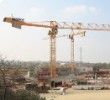
Cranes and Derricks Standard Takes Effect
Nov. 8 is a rarity on the safety and health calendar: An OSHA final rule became effective as of that date, having been published Aug. 9, 2010.
OSHA's final rule governing the use of cranes and derricks in construction took effect Nov. 8. Seven years in the making -- the negotiated rulemaking committee was formed in 2003 -- it replaces an outdated rule and will require operators of most types of construction cranes to be qualified or certified according to a method specified in 29 CFR 1926.1427. Employers have as much as four years to ensure all of their operators are qualified or certified, however, unless they are working in a jurisdiction that has its own operator requirements.
OSHA says about 4.8 million workers at 267,032 businesses will be affected by the rule. Among other things, it requires that qualified riggers be employed for rigging operations during assembly and disassembly, and it says employers must perform a pre-erection inspection of tower cranes.
Recordkeeping requirements within the rule include equipment ratings, employee training records, written authorizations from qualified individuals, and qualification program audits.